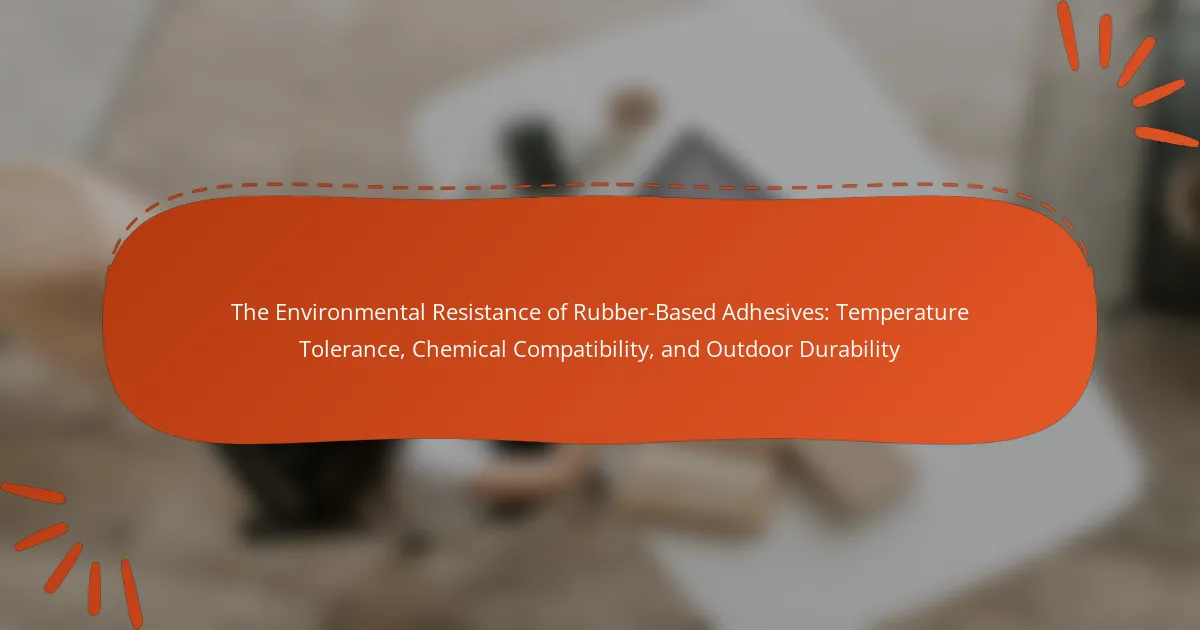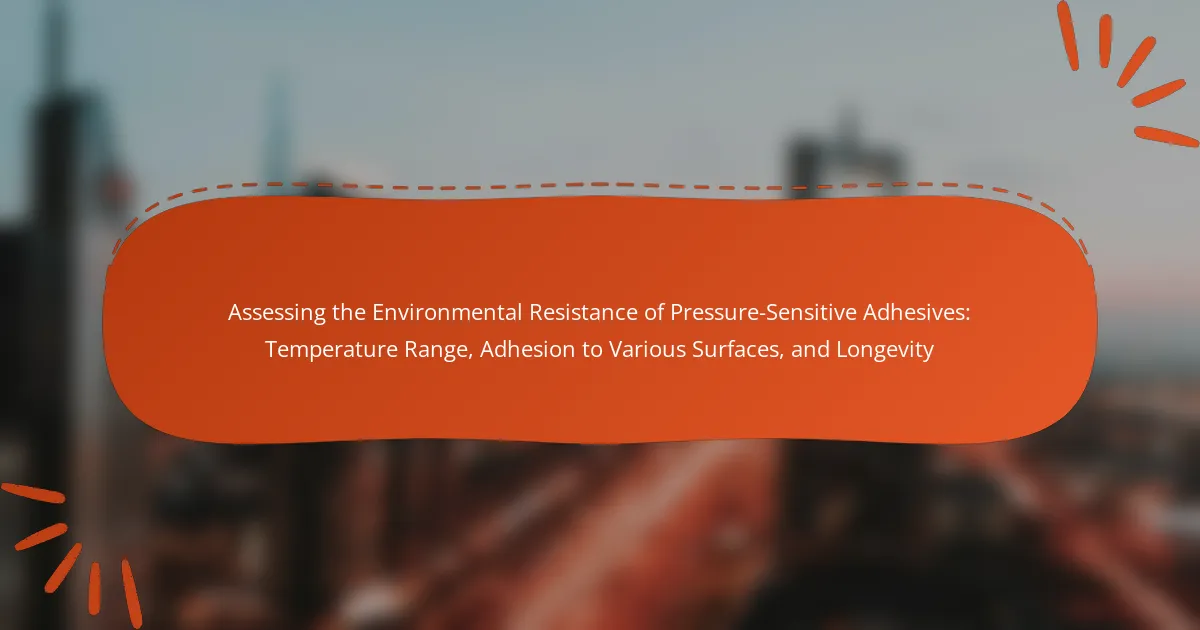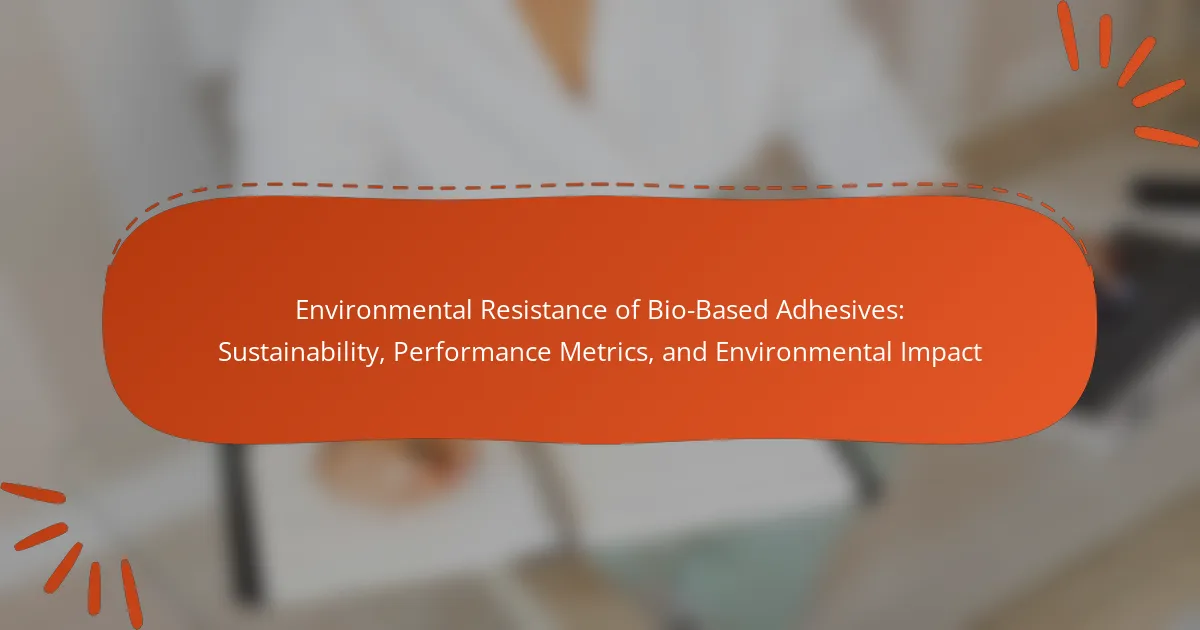Environmental resistance in specialty adhesives is the ability of these adhesives to endure various conditions such as moisture, heat, chemicals, and UV light while maintaining bond strength and performance. This article explores how different environmental factors affect specialty adhesives, including temperature variations, humidity, chemical exposure, and UV radiation. It highlights the importance of selecting adhesives based on specific application requirements, including substrate compatibility and environmental conditions. Additionally, the article provides guidelines for assessing adhesive properties, ensuring proper surface preparation, and following manufacturer instructions for optimal performance in demanding environments.
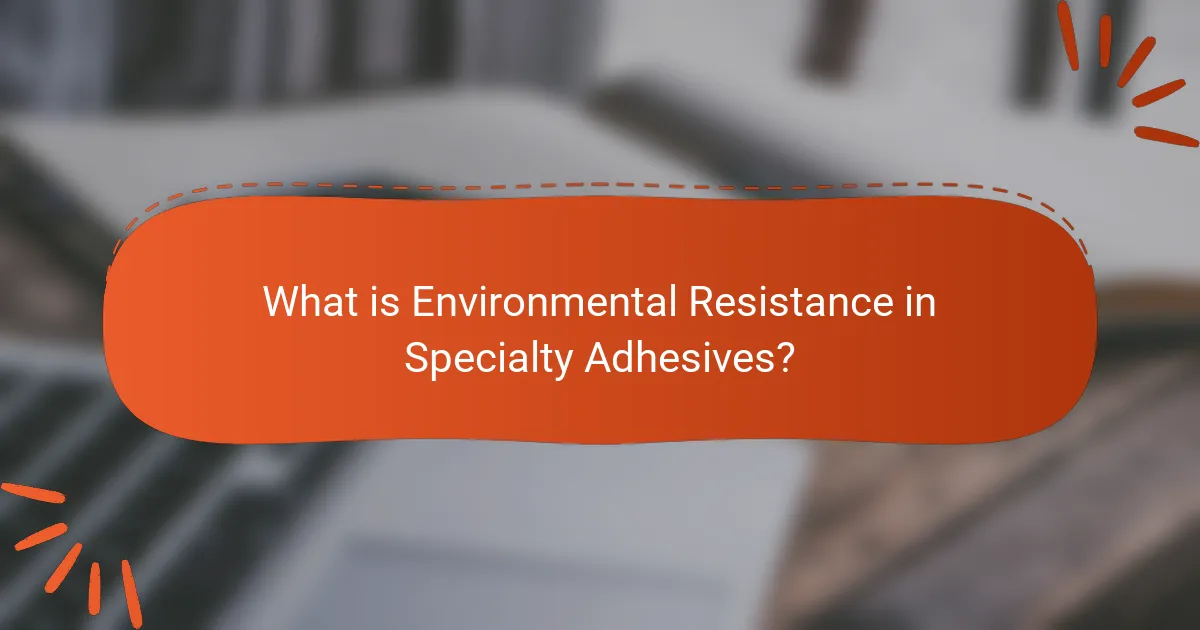
What is Environmental Resistance in Specialty Adhesives?
Environmental resistance in specialty adhesives refers to their ability to withstand various environmental conditions. This includes exposure to moisture, heat, chemicals, and UV light. Specialty adhesives are formulated to maintain their bond strength and performance under these challenging conditions. For instance, adhesives used in construction must resist water and temperature fluctuations. Research indicates that specific formulations can enhance durability and adhesion in extreme environments. These properties are critical for applications in automotive, aerospace, and construction industries where reliability is essential.
How is environmental resistance defined in the context of specialty adhesives?
Environmental resistance in specialty adhesives refers to their ability to withstand various environmental conditions without degradation. This includes resistance to moisture, temperature fluctuations, chemicals, and UV exposure. Specialty adhesives are formulated to maintain their bond strength and performance in challenging environments. For instance, some adhesives can endure high humidity levels without losing adhesion. Others are designed to resist solvents or harsh chemicals, ensuring longevity in industrial applications. The effectiveness of these adhesives in extreme conditions is often validated through standardized testing methods, which measure performance metrics like shear strength and thermal stability.
What are the key components that contribute to environmental resistance?
Key components that contribute to environmental resistance include chemical stability, thermal stability, and moisture resistance. Chemical stability ensures that adhesives can withstand exposure to various chemicals without degrading. Thermal stability allows adhesives to maintain performance under high temperatures. Moisture resistance protects adhesives from degradation due to water exposure. Additionally, UV resistance helps prevent degradation from sunlight. These components collectively enhance the durability and longevity of specialty adhesives in diverse application scenarios.
Why is environmental resistance important for specialty adhesives?
Environmental resistance is crucial for specialty adhesives because it ensures their performance under varying conditions. Specialty adhesives often face exposure to moisture, chemicals, and temperature fluctuations. If adhesives lack environmental resistance, they may degrade, lose adhesion, or fail prematurely. For instance, adhesives used in construction must withstand rain and humidity without losing strength. Similarly, automotive adhesives need to resist fuels and oils to maintain structural integrity. The ability to endure these conditions extends the lifespan of the adhesive and the overall product. Research indicates that adhesives with high environmental resistance can maintain their bonding properties for years, even in harsh environments.
What are the primary types of environmental resistance?
The primary types of environmental resistance are chemical resistance, thermal stability, and moisture resistance. Chemical resistance refers to the ability of materials to withstand corrosive substances without degradation. Thermal stability indicates how well a material can maintain its properties under high temperatures. Moisture resistance is the capability of a material to resist water absorption and damage. These types of resistance are crucial for specialty adhesives used in various applications. For instance, adhesives exposed to harsh chemicals must exhibit high chemical resistance to ensure longevity and performance. Similarly, adhesives in high-temperature environments require excellent thermal stability to avoid failure. Moisture resistance is vital in humid conditions to prevent adhesive bond failure.
How does chemical resistance play a role in specialty adhesives?
Chemical resistance is crucial in specialty adhesives as it determines their ability to withstand exposure to various chemicals without degrading. Specialty adhesives are often used in environments where they encounter solvents, oils, and other harsh substances. High chemical resistance ensures that the adhesive maintains its bond strength and integrity under these conditions. For example, adhesives used in automotive applications must resist fuels and oils to ensure durability. According to industry standards, adhesives with high chemical resistance can significantly extend the lifespan of bonded assemblies. This resistance is achieved through specific formulations that incorporate resilient polymers and additives. Thus, chemical resistance directly influences the performance and reliability of specialty adhesives in demanding applications.
What factors influence the chemical resistance of specialty adhesives?
The chemical resistance of specialty adhesives is influenced by their chemical composition, curing process, and environmental conditions. Chemical composition determines the types of monomers and additives used, affecting resistance to specific chemicals. The curing process impacts the network structure, influencing how well the adhesive can withstand chemical exposure. Environmental conditions, such as temperature and humidity, can also alter the performance of the adhesive in chemical environments. For instance, adhesives exposed to high temperatures may degrade faster when in contact with solvents. Additionally, the presence of fillers can enhance or diminish chemical resistance depending on their nature and interaction with the adhesive matrix.
What role does thermal stability play in specialty adhesives?
Thermal stability is crucial for specialty adhesives as it determines their performance under varying temperature conditions. It ensures that adhesives maintain their bonding strength and integrity when exposed to heat. Specialty adhesives with high thermal stability can withstand elevated temperatures without degrading or losing their adhesive properties. This characteristic is particularly important in applications such as automotive and aerospace, where materials are subjected to extreme thermal environments. Research indicates that adhesives with thermal stability can endure temperatures exceeding 200°C without significant loss of performance. Therefore, thermal stability directly impacts the reliability and longevity of adhesive bonds in demanding applications.
How is thermal stability measured in specialty adhesives?
Thermal stability in specialty adhesives is measured through various testing methods. Common methods include thermogravimetric analysis (TGA) and differential scanning calorimetry (DSC). TGA assesses weight loss as the temperature increases, indicating thermal degradation. DSC measures heat flow associated with phase transitions, providing insight into thermal properties. These methods help determine the temperature thresholds at which adhesives maintain their integrity. Research has shown that adhesives with higher thermal stability can withstand elevated temperatures without significant degradation.
What are the implications of thermal stability on adhesive performance?
Thermal stability significantly impacts adhesive performance. Adhesives with high thermal stability maintain their bond strength under elevated temperatures. This stability prevents degradation of adhesive properties, ensuring longevity in applications exposed to heat. Conversely, adhesives lacking thermal stability may soften or break down, leading to bond failure. For example, epoxy adhesives exhibit excellent thermal stability, retaining performance in automotive and aerospace applications. Studies show that adhesives lose up to 50% of their strength when exposed to temperatures beyond their thermal limits. Thus, thermal stability is crucial for ensuring reliable adhesive performance in demanding environments.
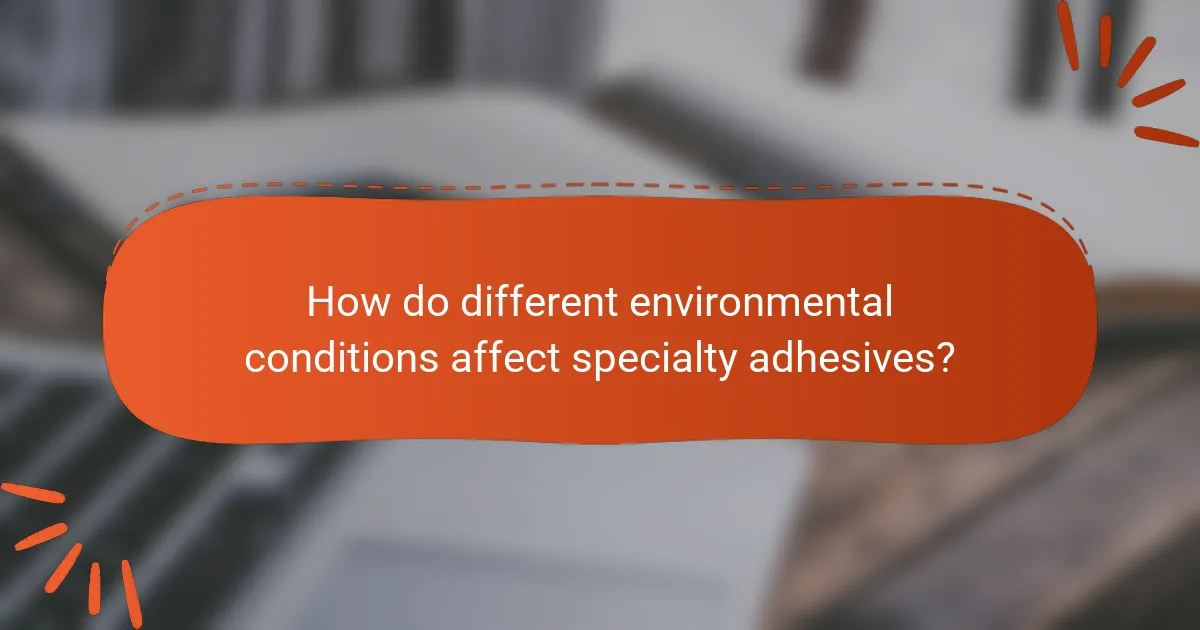
How do different environmental conditions affect specialty adhesives?
Different environmental conditions significantly affect specialty adhesives. Temperature variations can alter adhesive curing times and bond strength. High humidity levels may lead to moisture absorption, weakening the adhesive bond. Exposure to chemicals can cause degradation of adhesive properties, impacting durability. UV radiation can lead to photodegradation, reducing the adhesive’s effectiveness over time. These factors are critical for applications in harsh environments where adhesive performance is paramount. Studies show that adhesives designed for specific environmental conditions perform better, ensuring reliability in various applications.
What environmental factors impact specialty adhesives’ performance?
Environmental factors that impact specialty adhesives’ performance include temperature, humidity, and exposure to chemicals. Temperature variations can affect the curing process and bond strength. High humidity levels may lead to moisture absorption, weakening the adhesive bond. Chemical exposure can cause degradation or failure of the adhesive. UV radiation may also affect the longevity and stability of adhesives. These factors collectively determine the effectiveness and durability of specialty adhesives in various applications.
How do temperature fluctuations affect adhesive properties?
Temperature fluctuations significantly affect adhesive properties. Variations in temperature can lead to changes in viscosity, curing rates, and bond strength of adhesives. For instance, higher temperatures typically decrease viscosity, allowing for easier application. Conversely, lower temperatures can increase viscosity, making application more difficult.
Additionally, temperature fluctuations can impact the curing process of adhesives. Many adhesives require specific temperature ranges to cure effectively. Deviating from these ranges can result in incomplete curing, which compromises bond strength.
Research shows that adhesives exposed to extreme temperature variations may experience thermal degradation. This degradation can weaken the adhesive over time, reducing its effectiveness. For example, studies indicate that polyurethane adhesives lose significant bond strength when subjected to repeated freeze-thaw cycles.
In summary, temperature fluctuations can alter the physical and chemical properties of adhesives, affecting their performance and longevity.
What effects do humidity and moisture have on specialty adhesives?
Humidity and moisture can significantly affect specialty adhesives. High humidity levels can lead to premature curing or degradation of the adhesive’s properties. Moisture can also cause swelling in porous substrates, compromising the bond strength. Additionally, certain adhesives may experience reduced effectiveness due to hydrolysis, which breaks down the adhesive’s chemical structure. Research indicates that adhesives designed for high humidity environments often contain additives to improve moisture resistance. For example, polyurethane adhesives are known for their durability in moist conditions. Therefore, understanding the effects of humidity and moisture is crucial for selecting the appropriate adhesive for specific applications.
How do specialty adhesives perform in various application scenarios?
Specialty adhesives exhibit varying performance across different application scenarios. In high-temperature environments, certain specialty adhesives maintain structural integrity, withstanding temperatures up to 300°C. In humid conditions, moisture-resistant adhesives prevent bond failure, ensuring durability in outdoor applications. Chemical-resistant adhesives excel in environments exposed to solvents or acids, maintaining adhesion strength under harsh conditions. For electronic applications, conductive adhesives provide reliable electrical connections while resisting thermal cycling. Each adhesive type is formulated to address specific challenges, ensuring optimal performance tailored to its intended use.
What are the common application scenarios for specialty adhesives?
Specialty adhesives are commonly used in various application scenarios. These include automotive manufacturing, where they bond components for durability and weight reduction. In electronics, specialty adhesives secure components and provide insulation. Aerospace applications utilize these adhesives for their lightweight and strong bonding properties. Specialty adhesives are also prevalent in construction for sealing and bonding materials. Medical device manufacturing relies on them for safety and reliability. Additionally, they are used in the furniture industry for assembling components. Each scenario benefits from the unique properties of specialty adhesives, enhancing performance and longevity.
How does environmental resistance influence the choice of adhesive in specific applications?
Environmental resistance significantly influences the choice of adhesive in specific applications. Adhesives must withstand various environmental factors such as moisture, temperature fluctuations, and chemical exposure. For example, in outdoor applications, adhesives with high water resistance are essential to prevent degradation. Similarly, in high-temperature environments, adhesives with thermal stability are necessary to maintain bond integrity. Chemical resistance is crucial in industries like automotive and aerospace, where adhesives may encounter fuels or solvents. Selecting the right adhesive based on these environmental resistances ensures durability and performance in the intended application.

What are the best practices for selecting and using specialty adhesives?
Select specialty adhesives based on their specific application requirements. Consider factors such as substrate compatibility, environmental conditions, and intended use. Assess the adhesive’s chemical resistance and thermal stability. Review technical data sheets for performance characteristics. Test the adhesive on a small area before full application. Ensure proper surface preparation for optimal adhesion. Follow manufacturer instructions for curing time and conditions. Store adhesives according to recommended guidelines to maintain effectiveness.
What criteria should be considered when selecting a specialty adhesive?
The criteria to consider when selecting a specialty adhesive include chemical resistance, thermal stability, and application scenarios. Chemical resistance is crucial for ensuring the adhesive can withstand exposure to various substances without degrading. Thermal stability indicates how well the adhesive performs under temperature fluctuations. Application scenarios involve understanding the specific conditions and materials the adhesive will be used with. These factors directly influence the adhesive’s performance and longevity in real-world situations. Selecting the right adhesive based on these criteria helps prevent failures and ensures effective bonding.
How can users ensure optimal performance of specialty adhesives in challenging environments?
Users can ensure optimal performance of specialty adhesives in challenging environments by selecting the right adhesive formulation for specific conditions. Understanding the environmental factors such as temperature, humidity, and chemical exposure is crucial. Users should also prepare surfaces properly to enhance adhesion. This includes cleaning and roughening surfaces to improve bonding. Additionally, curing conditions must be monitored closely to achieve full strength. Using adhesives within their specified temperature and humidity ranges is essential. Regular testing of bond strength in relevant conditions can help identify potential failures. Research indicates that improper application can lead to reduced performance, so adherence to manufacturer guidelines is vital.
What are common troubleshooting tips for environmental resistance issues in specialty adhesives?
Common troubleshooting tips for environmental resistance issues in specialty adhesives include ensuring proper surface preparation. Clean surfaces remove contaminants that can affect adhesion. Next, verify the adhesive’s compatibility with the materials being bonded. Some adhesives are formulated for specific substrates. Additionally, monitor temperature and humidity during application. Extreme conditions can compromise adhesive performance. It’s also crucial to follow the manufacturer’s guidelines for curing times and conditions. Inadequate curing can lead to reduced resistance. Lastly, conduct tests on small samples before full application. This helps identify potential issues early.
Environmental resistance in specialty adhesives refers to their ability to withstand conditions such as moisture, heat, chemicals, and UV light. This article examines the critical components contributing to environmental resistance, including chemical stability, thermal stability, and moisture resistance, and their importance in applications across automotive, aerospace, and construction industries. It also highlights how various environmental factors, such as temperature fluctuations and humidity, impact adhesive performance, and provides best practices for selecting and using specialty adhesives effectively in challenging environments. Additionally, troubleshooting tips for addressing environmental resistance issues are discussed to ensure optimal adhesive performance.

